by tmoffett | Sep 23, 2010 | Black and White, Composition, Landscape, Photo tips
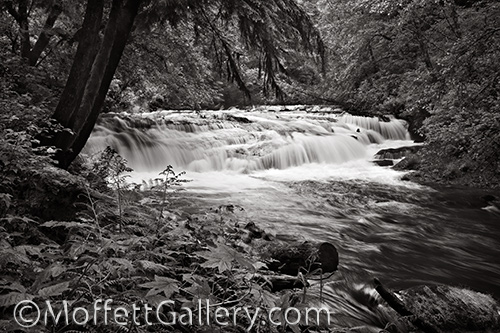
Knowles Creek
One of the most beautiful small rivers I have visited is Knowles Creek in western Oregon. One summer afternoon Christeena and I took a small hike along its banks, and along one section we walked there was nearly a mile of nonstop, staircase type waterfalls. There was nearly too much water to get nice photographs. When it comes to shooting waterfalls, I prefer just a little water as it tends to photograph better than a whole lot of water. When there is too much flow, the water just turns to a white, textureless streak. With less water a soft, ribbon like effect happens. It is much more interesting that way. You can almost feel the flow of the water.
There is just something about kicking back and relaxing on the banks of a river. The sound of the running water and the fresh air of the outdoors is so peaceful and nice. Even the occasional rainfall that came down didn’t disrupt the feeling in the air. I could hang out in the outdoors year round without a problem. It is my kind of life. Just me, my family and my camera. Wouldn’t that be nice!
by tmoffett | Sep 22, 2010 | Black and White, Composition, Landscape, Photographic Philosophy
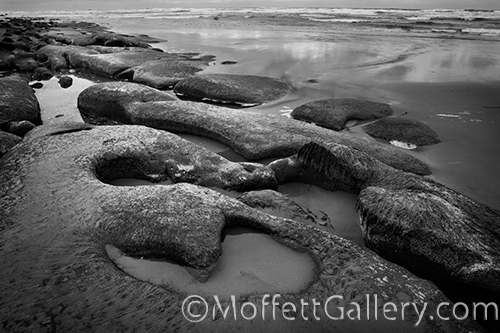
Ebb Tide, Ona Beach, Oregon
This past summer was very productive. I had many opportunities to photograph and not a lot of time to process the images. Here it is the middle of September and I am still working on files that were shot several months ago. I just processed this image last night, and as I was reviewing my files, wondered how I missed this on the first round of editing. The shapes, the reflections, the storm moving in, it all seems to work together.
The first time I went to Ona Beach I got all set up, camera on the tripod, composed and then came the downpour, before I even got off an exposure. I had never seen a storm move in so fast as that one did. So I went back the next day. It was incredible. The stones on the beach, carved by the water as it came and went with the tide, were dotted with pockets of water left by the receding tide, surrounded by mossy growth unlike anything I had ever seen before. It was really cool. The light was low and soft, as the sun was covered with light clouds. It had been raining but was starting to break up. I couldn’t have asked for a better day at the beach. And this beach, I could go back to over and over and never tire of it.
The calm after a storm as the clouds lighten and the sun begins to break through, the smell of fresh, clean air and the soft light, these are feelings that I like to show and have the viewer feel in my landscape photographs. If I feel them, I can create them. It is all about photographing from the heart. If I am constantly thinking about the technique to be used, then I will fail to capture a feeling or emotion. I must know the technical aspects of the process intuitively. It must be a part of me, then, and only then will I begin to create images with meaning. Many photographers think that it is all about technique, when really it is all about feeling. I must feel the image first, then I can create it.
by tmoffett | Sep 10, 2010 | Black and White, Landscape, Photo tips
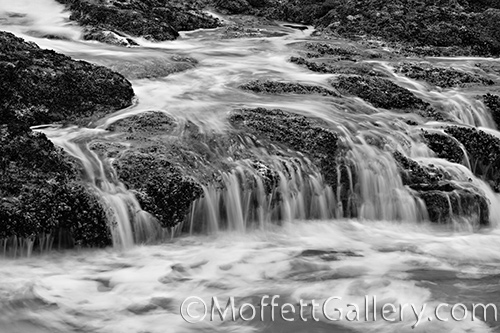
Shoreline, Yachats, Oregon
The evening we arrived in Yachats we were met with rain, however that did not stop me from photographing. We climbed out on the rocky shelf overlooking the sea and watched the waves come in. It was quite a spectacle. The waves would crash into the rock and spray seawater everywhere. The water would rush up on the shelf and then slowly retreat to the ocean just in time to meet the next wave. I photographed the waves for a while and then turned my camera inland and watched and photographed the retreating water. It appeared as a river flowing downstream and over small falls. As I photographed, Christeena was holding an umbrella, not knowing which way to hold it. Should she keep the rain off of me and the equipment of protect me from the ocean spray? It didn’t matter. Either way I got wet!
I often have students say they couldn’t photograph because of inclement weather. I only need to show them a few images and they realize that they are only making excuses. Some of my best photographs have been made during stormy weather. Students quickly learn that I won’t accept excuses of this kind, as I know, and they soon learn, that great opportunities are missed by not photographing during a storm. They just need to find a way to keep their gear dry and protected. This can be accomplished quite easily with an umbrella or even a garbage bag. When that is accomplished, a whole new world of creativity and opportunity are opened up. I love a good storm.
by tmoffett | Sep 8, 2010 | Black and White, Composition, Landscape, Photo tips
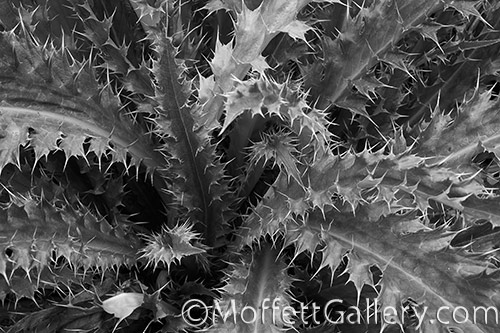
Untitled
When working in black and white, there are many factors to consider while making the photograph. Tonal range, local contrast and composition to name a few. Usually the overall tonal range should go from a deep black to bright white while maintaining good detail throughout. If the exposure is off at all, loss of detail on one end of the scale or the other becomes a problem. Light quality is ever important in creating images with a great tonal range. Once the overall tonal range is established, local contrast, the contrast between to adjacent objects in the image, must be controlled. In the darkroom, I control this by using different grades of paper. With digital, I use curves adjustment layers with layer masking. When everything is just right you will end up with a print with rich tones and great detail.
Composition is another whole ball game. In the above image, line, repetition, texture and rule of thirds are all important. They work together to lead the viewers eye from the outside down inside the plant. While traveling down the plant, every prickly point is rendered in rich detail. I begin to feel the image. I know I do not want to touch it. It is sharp and prickly. the eye is led to the lower left quadrant, off center just enough to create interest.
I love black and white. Quality black and white photography is becoming a lost art. Digital cameras have made it too easy that we forget at times to slow down and think before pressing the shutter. Shooting by instinct is great, but first learn technique so that when shooting by instinct or feeling you get the tones and composition right. It will improve your photography, I promise!
by tmoffett | Sep 4, 2010 | Black and White, Landscape
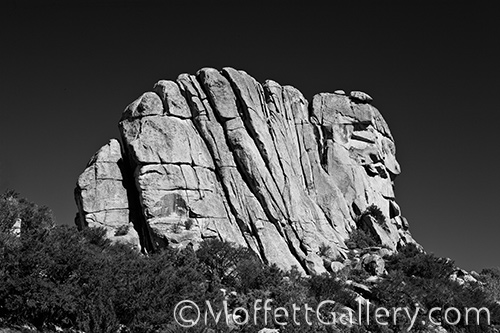
Bread Loaf Rock, City of Rocks
We have some great opportunities for landscape photography in Idaho. City of Rocks is just one of many locations with unique landscape characteristics that make for an exciting morning of photography. This area is filled with rock climbers, as the face of the rocks make for some challenging climbing routes. I prefer photographing without much human element, so fortunately for me, most of the climbers were still eating breakfast while I was out in the field making images.
This image of Bread Loaves was taken just as I was finishing up for the day, and the rock climbers were just starting to find their routes up the face of the rocks. Early mornings, just as the sun rises is a great time for photography, but about an hour past sunrise the light becomes harsh and the scenes have less appeal to me. The soft, moody light diminishes quickly as the sun rises in the sky, and although we can still look and see the beauty, capturing it in camera becomes a greater challenge. The sky, here, was totally clear and cloud free, which made for a simple background for the monolith protruding from the ground. Clouds, I think would have been a distraction.
by tmoffett | Aug 30, 2010 | Black and White, Photographic Philosophy, Ramblings

Clouds #16
In landscape photography, clouds can be a very big asset. Clouds affect the background area of the image, they affect light quality, and sometimes they can be the entire subject of the image. I love chasing storms in search of the perfect clouds. I have learned to create images with or without them, but my preference is always to have them.
One particular summer afternoon I didn’t even have to go in search of them, they came to me! I notice from inside the house that the light was changing, and so I went outside to check it out and as I looked up I saw some of the most incredible cloud formations I had ever seen. The clouds became my subject that afternoon. I put on my 200mm lens and began photographing smaller sections of the cloud formations instead of using the usual wide angle lens to capture the whole sky. Everything in the viewfinder became abstract. Some images, like the one above appeared to be inverted as well as having the appearance of having been shot from above. I had a great time exploring nature in my front yard that afternoon. It is a wonderful experience to create images while right at home.








Recent Comments